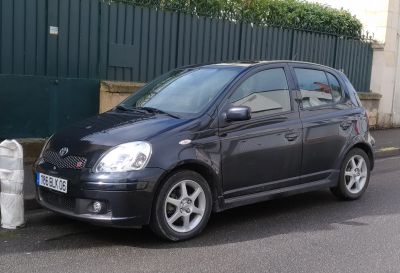 2003 Toyota Yaris I (facelift 2003) 3-door Dimensions, Size & Specs
2003 Toyota Yaris I (facelift 2003) 3-door Dimensions, Size & SpecsMeasurements of the 2003 Toyota Yaris I 3-door, engineered for optimal performance and comfort
| Dimensions | |
|---|---|
| Length: | 3640-3660 mm143.3-144.1 in11.9-12.0 ft |
| Width: | 1660 mm65.4 in5.4 ft |
| Height: | 1470-1500 mm57.9-59.1 in4.8-4.9 ft |
| Ground Clearance: | 105 mm4.1 in0.3 ft |
| Trunk Capacity: | 205 liter7.2 cu ft |
| Trunk Capacity (Max): | 950 liter33.5 cu ft |
| Weight Specifications | |
| Curb Weight: | 880-970 kg1940-2138 lbs |
| Maximal permitted Weight: | 1370-1410 kg3020-3109 lbs |
| Tire Specifications | |
| Rims Sizes: | 14-inch rims:
|
| Tire Sizes: |
|
The 2003-2005 Toyota Yaris I facelift 3-door hatchback is a compact and practical city car designed for efficiency and maneuverability. Measuring between 3640 and 3660 mm in length (approximately 143.3 to 144.1 inches), it offers a modern yet compact footprint suitable for urban driving and tight parking spaces. With a width of 1660 mm (65.4 inches), the Yaris offers a balanced cabin width that accommodates four to five passengers comfortably. Depending on the trim and equipment, the vehicle's height ranges from 1470 to 1500 mm (57.9 to 59.1 inches), providing an adequate headroom without compromising the sleek hatchback silhouette.
Weighing between 880 and 970 kg (1940 to 2138 lbs) in curb weight, the Yaris remains lightweight, contributing to its agility and fuel efficiency. The maximum permissible weight ranges from 1370 to 1410 kg (3020 to 3108 lbs), ensuring sufficient load capacity. Ground clearance is modest at 105 mm (4.13 inches), which suits well-paved urban roads but might require caution on rough terrain.
One of the highlights of this Yaris generation is its versatile luggage space. The standard boot capacity stands at 205 liters (7.24 cubic feet), which increases significantly to 950 liters (33.54 cubic feet) when the rear seats are folded down, enhancing the car's practicality for everyday cargo transport or light travel needs.
The car runs on a variety of rim sizes, including 5.5J x 14, 5.5J x 15, 6.5J x 15, and 6.5J x 16 wheels, paired with tire sizes from 175/65 R14 up to 195/45 R16, offering a choice between comfort and sporty handling.
Overall, the 2003-2005 Toyota Yaris I facelift 3-door compact hatchback combines efficient dimensions, lightweight construction, and functional cargo space, making it a popular choice for drivers seeking an economical and adaptable small vehicle in urban environments.
Discover the standout features that make the 2003 Toyota Yaris I 3-door a leader in its class
Have a question? Please check our knowledgebase first.
The Toyota Yaris I facelift 2003 3-door has a length ranging from 3640 mm to 3660 mm, which converts approximately to 143.3 to 144.1 inches (about 11.9 to 12 feet). This compact length makes it highly maneuverable in urban settings and easier to park compared to larger cars.
The width of the Toyota Yaris I facelift 2003 3-door is 1660 mm, equivalent to around 65.4 inches (about 5.45 feet). This width contributes to a balanced footprint that provides stable handling while remaining narrow enough for tight city streets and parking spaces.
The height of this Yaris generation ranges from 1470 mm to 1500 mm, translating to approximately 57.9 to 59.1 inches (around 4.8 to 4.9 feet). This moderate height offers a practical balance by ensuring ample headroom for passengers in a compact hatchback form while promoting aerodynamic efficiency for better fuel economy.
The curb weight of the Yaris I facelift 2003 3-door ranges between 880 kg and 970 kg, which is about 1940 to 2140 pounds. This relatively light weight contributes to improved fuel efficiency, agile handling, and easier maneuverability, making it a practical choice for urban environments.
The maximum weight for this Yaris model lies between 1370 kg and 1410 kg, equivalent to roughly 3020 to 3108 pounds. This figure includes the vehicle's curb weight plus passengers, cargo, and optional accessories, ensuring the car operates safely within designed structural limits.
With all seats upright, the Yaris I facelift 3-door provides 205 liters (about 7.2 cubic feet) of luggage space, sufficient for daily errands and small trips. Folding the rear seats increases capacity dramatically to 950 liters (approximately 33.5 cubic feet), allowing for bulky items or larger cargo loads, enhancing the versatility of this compact hatchback.
Yes, the Toyota Yaris I facelift 2003 3-door comfortably fits into a standard home garage. Most standard garages measure approximately 2.4 to 3 meters (7.9 to 9.8 feet) wide and 4.8 to 6 meters (15.7 to 19.7 feet) long, while the Yaris's compact length of around 3.64 to 3.66 meters (11.9 to 12 feet) and width of 1.66 meters (5.45 feet) make it well-suited for typical garage dimensions, leaving extra space for ease of access and storage.
Compared to its predecessor (the original Yaris released in the late 1990s), the facelifted 2003 model maintains very similar overall external dimensions, with slight refinements to length, width, and height that improve interior packaging and aesthetics. The 2003 facelift enhanced styling cues and aerodynamics but generally retained the compact footprint which contributed to the Yaris's reputation for excellent urban maneuverability and practicality. Weight adjustments due to added features and safety also slightly affected curb weight, but overall, the size remained consistent within the subcompact segment.
The Toyota Yaris I facelift 2003 3-door competes closely with other subcompact hatchbacks such as the Ford Fiesta, Honda Fit, and Volkswagen Polo. In terms of length, it is on the smaller to mid-size end with 3640-3660 mm (143.3-144.1 inches), making it slightly shorter or comparable to its rivals. Its width of 1660 mm (65.4 inches) is typical for the class, providing a good balance of interior space and exterior compactness. The Yaris tends to have a competitive curb weight in the 880–970 kg (1940–2140 lbs) range, contributing positively to fuel efficiency and nimble handling. Overall, it strikes a fine balance between compactness for city driving and enough interior space for passengers, making it a strong contender in its segment.
The facelifted Yaris I 3-door offers multiple rim sizes, including 5.5J x 14, 5.5J x 15, 6.5J x 16, paired with tire sizes such as 175/65 R14, 185/55 R15, and 195/45 R16. These variations allow buyers to choose between standard and sportier configurations. Smaller rims with higher-profile tires (e.g., 175/65 R14) tend to provide a softer, more comfortable ride by better absorbing road imperfections, ideal for daily commuting. Larger rims with lower-profile tires (e.g., 195/45 R16) often enhance handling and cornering stability, giving the car a sportier feel but potentially reducing ride comfort slightly on rough surfaces. Overall, the available tire and rim sizes give a good balance between ride quality and driving dynamics.
Discover similar sized cars.

| Production: | 1998-2008 |
|---|---|
| Model Year: | 1999 |
| Length: | 3660 mm144.1 in |
| Width: | 1625 mm64.0 in |
| Height: | 1485 mm58.5 in |

| Production: | 1998-2008 |
|---|---|
| Model Year: | 1998 |
| Length: | 3660 mm144.1 in |
| Width: | 1625 mm64.0 in |
| Height: | 1480 mm58.3 in |

| Production: | 2003-2005 |
|---|---|
| Model Year: | 2003 |
| Length: | 3640-3660 mm143.3-144.1 in |
| Width: | 1660 mm65.4 in |
| Height: | 1470-1500 mm57.9-59.1 in |

| Production: | 2016-2019 |
|---|---|
| Model Year: | 2016 |
| Length: | 3628 mm142.8 in |
| Width: | 1910 mm75.2 in |
| Height: | 1516 mm59.7 in |

| Production: | 2016-2019 |
|---|---|
| Model Year: | 2016 |
| Length: | 3665 mm144.3 in |
| Width: | 1660 mm65.4 in |
| Height: | 1500 mm59.1 in |

| Production: | 2013-2016 |
|---|---|
| Model Year: | 2013 |
| Length: | 3665 mm144.3 in |
| Width: | 1660 mm65.4 in |
| Height: | 1500 mm59.1 in |

| Production: | 2016-present |
|---|---|
| Model Year: | 2016 |
| Length: | 3660 mm144.1 in |
| Width: | 1893 mm74.5 in |
| Height: | 1490 mm58.7 in |

| Production: | 2012-2016 |
|---|---|
| Model Year: | 2012 |
| Length: | 3657 mm144.0 in |
| Width: | 1893 mm74.5 in |
| Height: | 1485 mm58.5 in |
